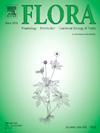匍匐茎外来入侵植物与同源本土植物胁迫信号克隆整合的不同效益
IF 1.8
4区 生物学
Q3 ECOLOGY
引用次数: 0
摘要
在异质资源供给下,克隆生长的外来入侵植物比本地入侵植物更能从克隆整合中获益。然而,外来入侵克隆植物和本土同源植物之间非资源物质(如胁迫信号或激素)易位的不同益处尚不清楚。为了解决这一问题,我们进行了盆栽试验,研究了外来入侵植物三叶裂叶橐吾(Wedelia trilobata,简称Wedelia)和本土同属植物华橐吾(W. chinensis)在干旱胁迫(20%土壤湿度)下,局部外源ABA诱导的胁迫信号在克隆网络中的易位。在施用ABA后2 ~ 3 d,三叶甘油三酯幼苗叶绿素荧光参数(Fv/Fm、ΦPSII和qP)和光合参数(Pn和Gs)显著升高。相比之下,中国白杨表现出延迟反应,幼株的Fv/Fm仅在3天后才出现显著增加,Pn和Gs的增加延迟到17天后。当ABA施用于幼株时,观察到类似的时间差异;三叶橐吾老分株对叶绿素荧光和光合参数的响应要快于中国橐吾。实验结束时,外源ABA的施用显著促进了外来入侵植物三叶木犀草的生物量积累,但对中国木犀草的生物量积累影响不显著。提示胁迫信号的易位对外来入侵克隆植物的生长性能的促进作用大于其原生同系物。因此,胁迫信号的易位可能使入侵的外来无性系植物比本地植物具有竞争优势,从而进一步促进其入侵性。本文章由计算机程序翻译,如有差异,请以英文原文为准。
Different benefit from clonal integration of stress signal between a stoloniferous alien invasive plant and its congeneric native one
Under heterogeneous resource supply, alien invasive plants with clonal growth can benefit more from clonal integration than their native ones. However, different benefit from translocation of non-resource substance (such as stress signal or hormone) between invasive alien clonal plants and native congener remains poorly understood. To address this, we conducted a pot experiment to explore translocation of stress signal, induced by local exogenous abscisic acid (ABA) application, within clonal networks of alien invasive plant Wedelia trilobata and native congeners W. chinensis subjected to drought stress (20 % soil moisture). In W. trilobata, chlorophyll fluorescence parameters (Fv/Fm, ΦPSII and qP) and photosynthetic parameters (Pn and Gs) of young ramets significantly increased 2–3 days after ABA application to old ramets. In contrast, W. chinensis exhibited a delayed response, with a significant increase in Fv/Fm of young ramets observed only after 3 days, and increases in Pn and Gs delayed until 17 days. A similar temporal difference was observed when ABA was applied to young ramets; chlorophyll fluorescence and photosynthetic parameters in old ramets of W. trilobata responded more rapidly than those in W. chinensis. At the end of experiment, exogenous ABA application significantly promoted biomass accumulation in alien invasive plant W. trilobata, but had no significant effect on the W. chinensis. It is suggested that translocation of stress signal may improve growth performance more in invasive alien clonal plant than its native congeners. Consequently, translocation of stress signal may confer a competitive advantage to invasive alien clonal plants over native plants, further contributing to its invasiveness.
求助全文
通过发布文献求助,成功后即可免费获取论文全文。
去求助
来源期刊

Flora
生物-植物科学
CiteScore
3.30
自引率
10.50%
发文量
130
审稿时长
54 days
期刊介绍:
FLORA publishes original contributions and review articles on plant structure (morphology and anatomy), plant distribution (incl. phylogeography) and plant functional ecology (ecophysiology, population ecology and population genetics, organismic interactions, community ecology, ecosystem ecology). Manuscripts (both original and review articles) on a single topic can be compiled in Special Issues, for which suggestions are welcome.
FLORA, the scientific botanical journal with the longest uninterrupted publication sequence (since 1818), considers manuscripts in the above areas which appeal a broad scientific and international readership. Manuscripts focused on floristics and vegetation science will only be considered if they exceed the pure descriptive approach and have relevance for interpreting plant morphology, distribution or ecology. Manuscripts whose content is restricted to purely systematic and nomenclature matters, to geobotanical aspects of only local interest, to pure applications in agri-, horti- or silviculture and pharmacology, and experimental studies dealing exclusively with investigations at the cellular and subcellular level will not be accepted. Manuscripts dealing with comparative and evolutionary aspects of morphology, anatomy and development are welcome.
 求助内容:
求助内容: 应助结果提醒方式:
应助结果提醒方式:


